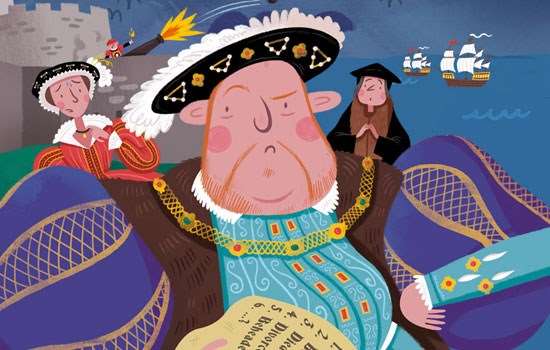Kids Rule! Henry VIII draw-along art tutorial
Learn to draw Henry VIII with Kids Rule! magazine illustrator Wesley Robins!
Have a piece of paper and a pen or pencil ready, and draw along with Wesley, as he shows you step-by-step how to portray this famous Tudor king. Then, add your own finishing touches using coloured pencils, pens or paints.
About Henry VIII
- Born: 28 June 1491, at Greenwich
- Parents: Henry VII and Elizabeth of York
- Became king: 1509
- Reigned: 36 years
- Died: 28 January 1547 at the Palace of Whitehall, London
- Successor: Edward VI (Henry VIII's son)
Henry VIII was the second son of Henry VII. After his older brother Arthur died in 1502, Henry became the heir to the throne. When he became king in 1509, he was tall, handsome, sporty and cultured.
Henry built lots of castles and is famous for having six wives and changing the religion of England during the Reformation. Let’s take a closer look at his life and reign…
Eltham Palace
Henry VIII spent much of his childhood living at Eltham Palace in London. It later became his royal country retreat.
Henry held feasts at Eltham Palace for many guests and in July 1517, a tiltyard (used for jousting) was created. He also had new royal lodgings and a brick chapel built.
Watch this video to learn more about Henry’s time at Eltham.
Heir Hunting
From the mid-1520s, Henry became obsessed with his quest for a legitimate male heir to become king after he died. Because of this, his romantic life was very rocky. Out of six wives, he divorced two and executed two.
Henry’s first wife, Katherine of Aragon, gave birth to many children, but sadly only one survived early childhood. She would grow up to become Queen Mary I, but Henry was determined that England should have a king, not a queen. He wanted to marry Anne Boleyn, but long negotiations with the Pope to get permission to divorce Katherine failed. Impatient to have a son, Henry made a decision that would turn England upside down. In 1533 he declared that he, not the Pope, was the head of the Church in England.
The Rocky Road to Reformation
Henry’s government organised the Dissolution of the Monasteries between 1536-41, which closed hundreds of religious houses, taking their lands and wealth. The monks and nuns who lived there had to find new places to live. There were protests and revolts against this, like the Pilgrimage of Grace in 1536-7, but they were brutally put down. The confiscated wealth of the monasteries made the king and many of his favoured subjects richer.
The Pope was furious that Henry had taken over religion in England. He tried to get the kings of Spain and France to gather armies to sail to England and remove Henry from power. Meanwhile, Henry prepared for war and came up with a plan (a ‘device’): he ordered the building of new castles and fortifications on England’s east and south coasts, where invasion was most likely.
Castles and coats of arms
Though they were built for war, Henry VIII’s castles are beautiful. Their stonework and interiors might look plain today, but were probably more colourful when first built. Most of the castles have Tudor coats of arms carved above the entrances. Each one is a shield bearing heraldic symbols – the three lions of England and the fleurs-de-lis of France, with an animal on each side. These are the lion of England and a dragon, a symbol of Henry VIII’s father’s ancestors who came from Wales.
Learn more about heraldry and coats of armsMore queens, please!
Jane Seymour, Henry’s third queen, died giving birth to a longed-for son, Edward. Then Anne of Cleves was rejected shortly after marrying Henry and his fifth wife, Katherine Howard, was beheaded for treasonous adultery. Henry’s sixth and final wife, Katherine Parr, outlived him. She narrowly escaped arrest for supporting the Protestant Christians, as despite his reformation, Henry was still a Catholic at heart.
Katherine Parr also helped to bring Henry's daughters, Mary and Elizabeth, back into the line of succession. This was important, as it meant that if their brother Edward died without having any children, Mary and then Elizabeth could become queen.
Girls Rule!
By the time he died in 1547, Henry had become tyrannical, overweight and unwell. He was succeeded by his only son, the young Edward VI, who was just nine years old. Sadly he died only a few years later, at 15. Edward had nominated his cousin Lady Jane Grey to be his successor. Her reign lasted for nine days before Henry’s eldest daughter (and Edward’s half-sister) Mary overthrew her to become Queen Mary I. She reigned for five years before Henry VIII’s second daughter, Elizabeth I became queen, and ruled for 44 years.
And so, despite the desperate quest for a son that took over Henry VIII’s reign, it is his daughter Elizabeth who is most well-known out of his children today.
Find out more abut Elizabeth IYou did it!
We love seeing your brilliant drawings of Henry VIII – here are some of our favourites!


